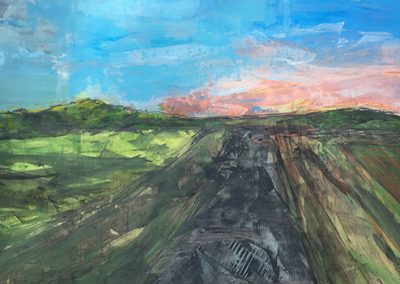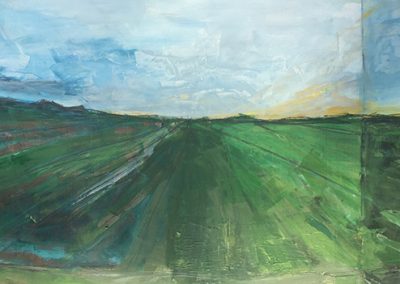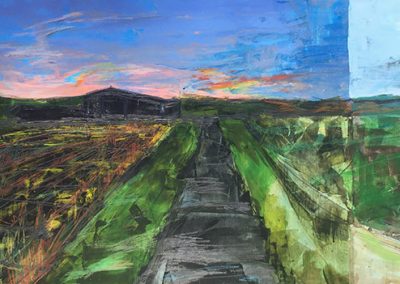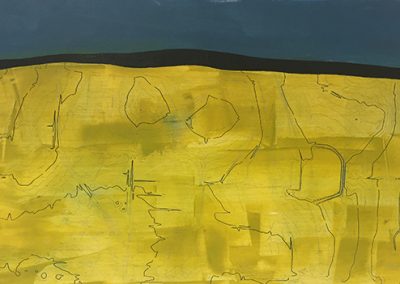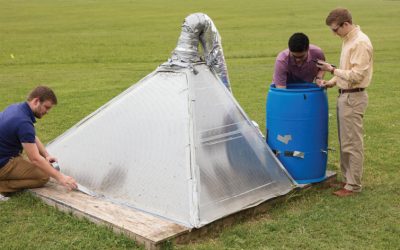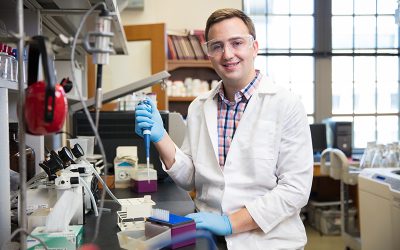Big Picture Data

 Rain or shine, at 7 a.m. every Tuesday for five months honors landscape architecture major Hannah Moll showed up, camera in hand, to document the university’s farm just north of campus. It wasn’t easy getting up that early, but proved to be well worth the effort for a designer and painter sensitive to the light and color shifts that come with daybreak.
Rain or shine, at 7 a.m. every Tuesday for five months honors landscape architecture major Hannah Moll showed up, camera in hand, to document the university’s farm just north of campus. It wasn’t easy getting up that early, but proved to be well worth the effort for a designer and painter sensitive to the light and color shifts that come with daybreak.
“I was on site, looking at the soybean fields where different cultivars were starting to die back,” Moll recalls. “It was so beautiful! Seeing the rust colors slide past silvery grays, with the morning light shining through them.”
Moll worked to capture that experience and others in a series of 32 paintings that record the shift of seasons at the Agricultural Research and Extension Center. Pieced together in a vividly colored, gestural panorama that swoops from aerial views of field rows and farm machinery to textured panels tracing the site’s contours, Moll’s honors thesis presents a familiar working landscape in an entirely new light. That’s exactly the point, she says.
“There’s a lot of data on this site – soils, hydrology, all of the layers that make up this ecology, a wealth of information that I can draw from. How can I add to it?”
Guided by faculty mentor Laura Terry, an associate professor of architecture and professional painter, and Phoebe Lickwar, an assistant professor of landscape architecture, Moll decided to explore how painting enriches site inventory and analysis, a critical first step in landscape architecture design. She discovered that paint beats software when it comes to capturing the essence of a place: “One thing about painting that’s so great – it allows you to break away from the conventions of drawing with a pencil or on a computer. It’s very tactile; you get a sense of place you don’t get with drawing. The medium sort of frees your mind.”
Moll has dabbled in painting and drawing as a creative outlet all of her life. She began to paint more regularly after a studio project several years ago, when students were charged with painting a site on Fayetteville’s Mount Kessler. Unsatisfied with her first effort, Moll ended up painting three different pieces, and won a Student Merit Award from the Arkansas chapter of the American Society of Landscape Architects – the first of four ASLA merit awards she’s won, which culminated in a 2017 Student Honor Award from the Arkansas chapter of the ASLA.
Moll prepared for her honors thesis by taking an oil painting class with Kristin Musgnug, an associate professor of art. “She trained me to think deeply about what color I was using, what stroke I was using, what sort of mark making – is it quiet, is it sort of rough, is it transparent, is it really textural,” Moll says. Musgnug also encouraged Moll to experiment with using a silicon wedge, which Moll ended up using extensively because it allows you to “see what’s underneath the paint surface, depending on how much pressure you use.”
At the suggestion of Laura Terry, Moll amplified the push-pull of adding and subtracting layers by throwing the School of Architecture’s laser cutter into the mix. She would paint a base layer, scan it, then work on the scanned image in Adobe Illustrator, adding layers that ranged from maps of field plots to pure texture. Then, she would feed the painted panel into the laser cutter, which would etch the Illustrator design onto the piece. Finally, she would go back over the work, teasing out certain details and scraping away others. “I felt like there was sort of a conversation going on, with the painting morphing and changing until you know it’s finished.”
In addition to the panorama, Moll bound her best photos into a series of three flip books, and assembled a 144”w by 32”h triptych that records the play of light and color on Field B4, a soybean field later planted with rye, over five months’ time.
“Typically we don’t think of data as being subjective,” Laura Terry said. “Hannah has painted something that everyone can respond to on a personal level, that offers people a way into a place to see it differently.”
Selections from Hannah Moll’s honors thesis are on display in the Honors College wing of Gearhart Hall through December 2017.
More Field Notes Stories
Capitalizing on Viral Videos
“There are a lot of YouTubers out there who are popular and using products spontaneously, which I believe is more powerful with Millennials.” Six students enter the Walton College Behavioral Business Research Lab, painted a soothing peach color to put them...
Pyramid Power
Garret Gardenhire, Kevin Le and Matt Annis monitor their solar-powered food dehydrator, designed to combat food insecurity in developing countries. Freshmen honors engineering students Garret Gardenhire, Kevin Le and Matt Annis inherited a simple machine and a big...
Growing Up and Growing Old: Developing Research Skills in the Aging Lab
Allen straps on a knee brace, designed to mimic the effects of arthritis on the joints; she hopes that her research will lead to a greater awareness of ageist attitudes.by Samantha Kirby “What?” I asked. “What?” My hearing was poor. I turned toward the speaker, but...
Double Duty for Future MD
As part of his biochemistry thesis, Will Pohlman developed a dye technique that may prove useful to pharmacological companies. Biochemistry and animal science proved to be the perfect double major for Sturgis Fellow Will Pohlman, who dreamed about a career...
Fashion for the 21st-Century Flower Child
“They’re incredible! Katie and Laura took a dream I had and made it happen – they’ve opening up a whole new area of research for our program.” The theme was “Futuristic Floral” and the student designers rose to the challenge: the models who strutted down the runways...



